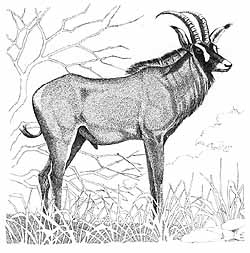English: Roan Antelope; French: Hippotrague; Acholi: Bùre; Afrikaans: Bastergemsbok; Amharic: Chele Balegame; Arabic: Abu Uruf; Bambara: Dajè; Basari: Engàw; Gbaya: Kàyà; Damara: !hoa !! nâhgaeb; Dinkà: Amon; Ful: Kooba, Nagga; Hausa: gwanki; Kiladi: Mbvuli; Kung: N!ho, nco; Kirundi: Inkoronko; Kiswahili: Korongo; Lozi: Kwalataseta; Nganguela: Mpengo; Sango: Kanga, vônga; Shaba: Tengo; Shangan: Xidhlanamane; Shona: Chengu, Ndunguza; Sindebele: Thaka; Sotho: Aluba-ka-lela, Thaetsi; Umbundu: Mpalanca; Wolof: Koba; Yoruba: Berewa; Zande: Moxo.
 |
Former distribution: Africa south of Sahara to the Cape; not in the rain forests.
Present distribution: Africa south of the Sahara; from Senegal, Gambia east to western Ethiopia, southern Sudan south to southern Uganda, south-western Kenya, Tanzania, western and southern Mozambique, southern and central Zaire, Zambia, central and northern Angola, northern Botswana, northern Namibia and in South Africa in eastern Transvaal and Swaziland. Introduced into Natal and northern Transvaal, Etosha Pan in Namibia and the Kruger National Park. Waterberg Nature Reserve in South Africa, the Rubon do Island on the Victoria Lake and Texas, USA.
Behaviour: Preferred habitat: open grass and woodlands in the vicinity of water; they live singly, in pairs or in small herds of up to 25; browse and graze on bushes, leaves and grass mainly at twilight. Predators include lions, leopards, wild dogs, hyenas and crocodiles. Sometimes they associate with herds of gnus, buffalos, zebras and oryx antelopes.
Population status: Endangered in West Africa and rare in all other distribution areas. Stable in national parks and game reserves.
Brief notes:
Body weight: 260-300 kg
Head and body length: 250-260 cm
Tail length: 50-70 cm
Shoulder height: 150-160 cm
Gestation period: 268-286 days
Maximum age: 17 years in captivity (18 in the wild?)
Trophy: Record (Hippotragus e. equinus) SCI: 81 4/8 score, 1970 Zambia, WILLIAM F. VIGOR; average 68 score. RW’s: 39″, Zimbabwe, South African Museum; average 27″. CIC: 206.95 points, 1978 Zaire, I.Z.C.N.; average 165 points.
Hunting methods: Stalking with trackers.
Subspecies: 6
1. Southern Roan Antelope Hippotragus e. equinus Zambia, western Malawi, western Mozambique, Zimbabwe, north-eastern Botswana, northern South Africa. Rare. Trophy: Record SCI: 81 6/8 score, 1984 Zambia, AGOSTINO MARRON MATTOLI; average 68 score.
2. Angolan Roan Antelope Hippotragus e. cottoni From the Congo Republic south to southern Angola and western Zaire; northern Namibia and northern Botswana. Rare. Trophy: Record SCI: 78 3/8 score, 1971 Angola, C.J. MCELROY; average 68 score. RW’s: 34″, Angola, M. L. CARVALHO; average 27 1/2″.
3. East African Roan Antelope Hippotragus e. langheldi South-western Kenya, Tanzania, southern Uganda, eastern Zaire? Rwanda-Burundi? Rare. Trophy: Record SCI: 85 score, 1984 Tanzania, DOC.I. THURSTON II; average 68 score. RW’s: 31 4/4″, East Africa, R.E. PHELON; average 26″.
4. Sudan Roan Antelope Hippotragus e. bakeri South Sudan, north-eastern Zaire, northern Uganda, western Ethiopia. Rare. Trophy: Record SCI: 83 4/8 score, 1982 Sudan, CARL NORMAN JR.; average 68 score. RW’s: 37 1/4, Sudan; average 27″.
5. Western Roan Antelope Hippotragus e. koba From Gambia and Senegal to Cameroon and Central African Republic. Endangered. Trophy: Record SCI: 90 1/8 score, 1983 Central African Republic, LES LUNDSTROM; average 70 score. RW’s: 36 1/4″, 1962 Central African Republic, R. FRADET; average 27″. CIC: 237.25 points, Chad, CTE. DE JANZE; average 165 points.
Remarks: Hippotragus e. scharicus, recognized by ANSELL (1972) from the Lake Chad and Chari regions, is omitted here and added to H.e. koba. Unfortunately the distribution areas have shrunk drastically within the last 25 years due to uncontrolled hunting and the destruction of habitat by domestic cattle and agricultural development. More information required on distribution and population status.






